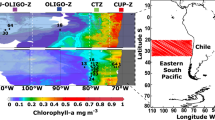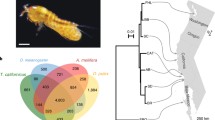Abstract
The cytochrome c oxidase subunit 2 gene (COII) encodes a highly conserved protein that is directly responsible for the initial transfer of electrons from cytochrome c to cytochrome c oxidase (COX) crucial to the production of ATP during cellular respiration. Despite its integral role in electron transport, we have observed extensive intraspecific nucleotide and amino acid variation among 26 full-length COII sequences sampled from seven populations of the marine copepod, Tigriopus californicus. Although intrapopulation divergence was virtually nonexistent, interpopulation divergence at the COII locus was nearly 20% at the nucleotide level, including 38 nonsynonymous substitutions. Given the high degree of interaction between the cytochrome c oxidase subunit 2 protein (COX2) and the nuclear-encoded subunits of COX and cytochrome c (CYC), we hypothesized that some codons in the COII gene are likely to be under positive selection in order to compensate for amino acid substitutions in other subunits. Estimates of the ratio of nonsynonymous to synonymous substitution (ω), obtained using a series of maximum likelihood models of codon substitution, indicated that the majority of codons in T. californicus COII are under strong purifying selection (ω << 1), while approximately 4% of the sites in this gene appear to evolve under relaxed selective constraint (ω = 1). A branch-site maximum likelihood model identified three sites that may have experienced positive selection within the central California sequence clade in our COII phylogeny; these results are consistent with previous studies showing functional and fitness consequences among interpopulation hybrids between central and northern California populations.



Similar content being viewed by others
References
Adkins RM, Honeycutt RL, Disotell TR (1996) Evolution of eutherian cytochrome c oxidase subunit II: heterogeneous rates of protein evolution and altered interaction with cytochrome c. Mol Biol Evol 13:1393–1404
Anisimova M, Bielawski JP, Yang Z (2001) Accuracy and power of the likelihood ratio test in detecting adaptive molecular evolution. Mol Biol Evol 18:1585–1592
Anisimova M, Bielawski JP, Yang Z (2002) Accuracy and power of Bayes prediction of amino acid sites under positive selection. Mol Biol Evol 19:950–958
Barreintos A, Muller S, Dey R, Wienberg J, Moraes CT (2000) Cytochrome c oxidase assembly in primates is sensitive to small evolutionary variations in amino acid sequence. Mol Biol Evol 17:1508–1519
Bayona-Bafaluy MP, Muller S, Moraes CT (2005) Fast adaptive coevolution of nuclear and mitochondrial subunits of ATP synthetase in orangutan. Mol Biol Evol 22:716–724
Brown MD, Wallace DC (1994) Molecular basis of mitochondrial disease. J Bioenerg Biomem 26:273–289
Burton RS (1986) Evolutionary consequences of restricted gene flow in the intertidal copepod Tigriopus californicus. Bull Mar Sci 39:526–535
Burton RS (1997) Genetic evidence for the persistence of marine invertebrate populations in an ephemeral habitat. Evolution 51:993–998
Burton RS (1998) Intraspecific phylogeography across the Point Conception biogeographic boundary. Evolution 52:734–745
Burton RS, Lee B-N (1994) Nuclear and mitochondrial gene genealogies and allozyme polymorphism across a major phylogeographic break in the copepod Tigriopus californicus. Proc Natl Acad Sci USA 91:5197–5201
Burton RS, Rawson PD, Edmands S (1999) Genetic architecture of physiological phenotypes: empirical evidence for coadapted gene complexes. Am Zool 39:451–462
Cann RL, Brown WM, Wilson AC (1984) Polymorphic sites and the mechanism of evolution in human mitochondrial DNA. Genetics 104:699–711
Dey R, Barrientos A, Moraes CT (2000) Functional constraints of nuclear-mitochondrial DNA interactions in xenomitochondrial rodent cell lines. J Biol Chem 275:31520–31527
Edmands S, Burton RS (1999) Cytochrome c oxidase activity in interpopulation hybrids of a marine copepod: a test for nuclear-nuclear or nuclear-cytoplasmic coadaptation. Evolution 53:1972–1978
Grossman LI, Wildman DE, Schmidt TR, Goodman M (2004) Accelerated evolution of the electron transport chain in anthropoid primates. Trends Genet 20:578–585
Harrison JS, Burton RS (2006) Tracing hybrid incompatibilities to single amino acid substitutions. Mol Biol Evol 23: 559–564
Holm L, Saraste M, Wikstrom M (1987) Structural models of the redox centres in cytochrome oxidase. EMBO J 6: 2819–2823
Kumar S, Tamura K, Jakobsen IB, Nei M (2001) MEGA2: Molecular Evolutionary Genetics Analysis software. Arizona State University, Temp
Millet F, deJong C, Paulson L, Capaldi R (1983) Identification of specific carboxylate groups on cytochrome c oxidase that are involved in binding cytochrome c. Biochemistry 22:546–552
Nelson WS, Prodohl PA, Avise JC (1996) Development and application of long-PCR for the assay of full-length animal mitochondrial DNA. Mol Ecol 5:807–810
Osheroff N, Speck SH, Margoliash E, Veerman ECI, Wilms J, Konig BW, Muijsers AO (1983) The reaction of primate cytochrome c with cytochrome c oxidase. J Biol Chem 258:5731–5738
Rand DM, Haney RA, Fry AJ (2004) Cytonuclear coevolution: the genomics of cooperation. TREE 19:645–653
Rawson PD, Burton RS (2002) Functional coadaptation between cytochrome c and cytochrome c oxidase within allopatric populations of a marine copepod. Proc Natl Acad Sci USA 99:12955–12958
Rawson PD, Brazeau DA, Burton RS (2000) Isolation and characterization of cytochrome c from the marine copepod, Tigriopus californicus. Gene 248:15–22
Roberts VA, Pique ME (1999) Definition of the interaction domain for cytochrome c on cytochrome c oxidase. III. Prediction of the docked complex by a complete, systematic search. J Biol Chem 274:38051–38060
Ruiz-Pesini E, Mishmar D, Brandon M, Procaccio V, Wallace DC (2004) Effects of purifying and adaptive selection on regional variation in human mtDNA. Science 303:223–226
Schmidt TR, Wu W, Goodman M, Grossman LI (2001) Evolution of nuclear- and mitochondrial-encoded subunit interaction in cytochrome c oxidase. Mol Biol Evol 18:563–569
Simon C, Frati F, Beckenbach A, Crespi B, Liu H, Flook P (1994) Evolution, weighting, and phylogenetic utility of mitochondrial gene sequences and a compilation of conserved polymerase chain reaction primers. Ann Entomol Soc Am 87:651–701
Swofford DL (1999) PAUP*: Phylogenetic Analysis Using Parsimony (*and other methods), version 4. Sinauer Associates, Sunderland, MA
Tsukihara T, Aoyama H, Yamashita E, Tomizaki T, Yamaguchi H, Shinzawa-Itoh K, Nakashima R, Yaono R, Yoshikawa S (1996) The whole structure of the 13-subunit oxidized cytochrome c oxidase at 2.8 Å. Science 272:1136–1144
Wang K, Zhen Y, Sadoski R, Grinnell S, Geren L, Ferguson-Miller S, Durham B, Millett F (1999) Definition of the interaction domain for cytochrome c on cytochrome c oxidase. II. Rapid kinetic analysis of electron transfer from cytochrome c to Rhodobacter sphaeroides cytochrome oxidase surface mutants. J Biol Chem 274:38042–38050
Willett CS, Burton RS (2001) Viability of cytochrome c genotypes depends on cytoplasmic backgrounds in Tigriopus californicus. Evolution 55:1592–1599
Willet CS, Burton RS (2003) Environmental influences on epistatic interactions: Viabilities of cytochrome c genotypes in interpopulation crosses. Evolution 57:2286–2292
Willet CS, Burton RS (2004) Evolution of interacting proteins in the mitochondrial electron transport system in a marine copepod. Mol Biol Evol 21:443–453
Wilson T, Cameron V (1994) Replacement of a conserved glycine residue in subunit II of cytochrome c oxidase interferes with protein function. Curr Genet 25:233–238
Witt H, Malatesta F, Nicoletti F, Brunori M, Ludwig B (1998) Tryptophan 121 of subunit II is the electron entry site to cytochrome-c oxidase in Paracoccus denitrificans. Biol Chem 273:5132–5136
Yang Z (1997) PAML: a program package for phylogenetic analysis by maximum likelihood. CABIOS 13:555–556 (http://www.abacus.gene.ucl.ac.uk/software/paml.html)
Yang Z (2004) PAML: a program package for phylogenetic analysis by maximum likelihood. User’s Guide vers. 3.14 (http://www.abacus.gene.ucl.ac.uk/software/paml.html)
Yang Z (2005) The power of phylogenetic comparison in revealing protein function. Proc Natl Acad Sci USA 102:3179–3180
Yang Z, Nielsen R (2002) Codon-substitution models for detecting molecular adaptation at individual sites along specific lineages. Mol Biol Evol 19:908–917
Zhen Y, Hoganson CW, Babcock GT, Ferguson-Miller S (1999) Definition of the interaction domain for cytochrome c on cytochrome c oxidase. I. Biochemical, spectral, and kinetic characterization of surface mutants in subunit II of Rhodobacter sphaeroides cytochrome aa3. J Biol Chem 274:38032–38041
Acknowledgments
We would like to thank C. Willett, J. Flowers, S. Harrison, and four anonymous reviewers for providing comments on an eary version of the manuscript. This research was supported by grants from the National Science Foundation to R.S.B. (DEB 94-09066, 98-15424, and 02-36363) and an NSF/Alfred P. Sloan Foundation Postdoctoral Fellowship in Molecular Evolution to P.D.R.
Author information
Authors and Affiliations
Corresponding author
Additional information
[Reviewing Editor: Dr. Willie Swanson]
Rights and permissions
About this article
Cite this article
Rawson, P.D., Burton, R.S. Molecular Evolution at the Cytochrome Oxidase Subunit 2 Gene Among Divergent Populations of the Intertidal Copepod, Tigriopus californicus. J Mol Evol 62, 753–764 (2006). https://doi.org/10.1007/s00239-005-0074-7
Received:
Accepted:
Published:
Issue Date:
DOI: https://doi.org/10.1007/s00239-005-0074-7




